Self-Driving Truck Market Research, 2035
The global self-driving truck market size is projected to be valued at $13.1 billion in 2025, and is expected to reach $41.2 billion by 2035, growing at a CAGR of 12.1% from 2025 to 2035.
Report Key Highlights:
- The report covers a detailed analysis on the self driving truck technology used in vehicle automation.
- The market has been analyzed from the year 2025 till the year 2035.
- Latest developments have been mentioned in the research study.
- Top companies operating in the industry has been profiled in the research study.
- The research study includes different segments & regions across which the market has been analyzed.
Self-driving truck refers to an autonomous truck that can drive itself through a combination of software & hardware installed and mounted on it. The trucks can sense their surroundings and navigate accordingly due to the advanced technology installed within them. In addition, they can detect pedestrians, road signs, and other vehicles and make real-time decisions to ensure safe and efficient movement of the vehicle, passengers, and surroundings. The technology that helps to drive the truck autonomously and make effective decisions at the time of any hindrance or obstruction is known as self-driving technology.
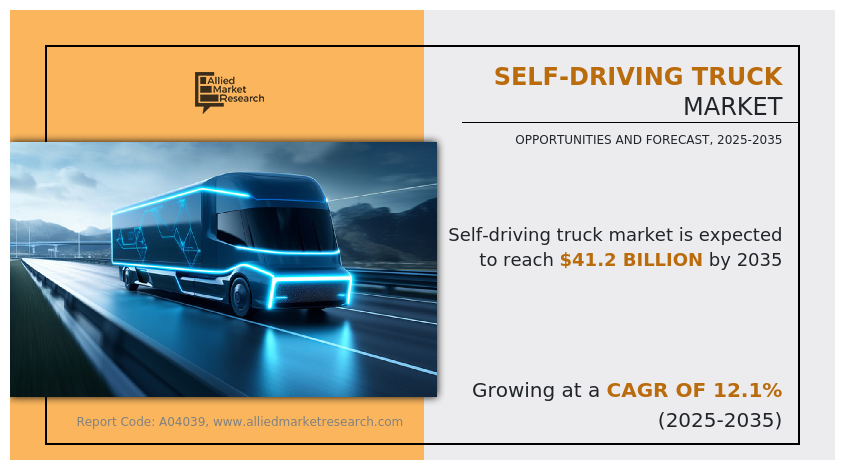
The technology includes sensors such as LiDAR, RADAR, vision sensor and ultrasonic sensors and other equipment to detect the trucks surrounding. The trucks are equipped with sensors and software which drive the hardware to complete tasks as per their coding or programming. The other aspect is the service offered by the manufacturers to enhance and support the technology to give the best output from both the technology and truck.
The self-driving truck is used in numerous sectors for applications such as long-haul transportation, last mile delivery, mining, and ports. The self-driving trucks help the organization to be cost effective as the self-driving trucks help the driver to relax and get comfortable when performing shipping to the remote areas or moving on highways. The self-driving truck and technology are making its impact in the mining as well by performing monotonous tasks and carrying heavier loads with no malfunction in the trucks and technology. Similarly, technology has made its way into the ports where it is carrying heavier loads or goods with ease and helping the authorities to perform complex tasks easily and safely.
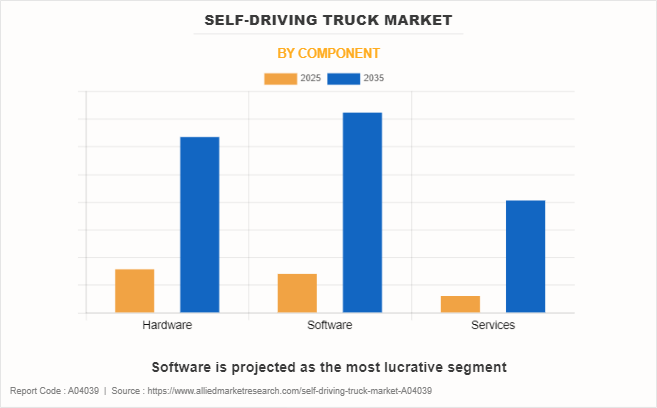
In addition, with the advancement in technology, self-driving vehicle technology companies have developed & introduced advancements in software that are being used by numerous OEMs in their prototype & concept autonomous trucks. These trucks are in the development & trial phase, wherein the vehicle is being tested in all conditions such as rough terrain, busy traffic routes, and others to check the performance of the vehicle. In addition, the key OEMs operating in the industry have made strategic plans to commercialize their upcoming models in the near future. For instance, in November 2022, Waabi launched its first-generation truck software designed specifically for OEM integration. The Waabi Driver, a combination of Waabi's software, sensors, and computation, powers the trucks.
Similarly, in April 2023, Aurora Innovation, Inc. launched its first commercial-ready terminal for self-driving trucks, ushering in a new age of commercial operations in the autonomous trucking industry. Aurora's next-generation South Dallas terminal is designed with unique features needed for driverless operations, and it will serve as a model for Aurora's future terminal network. Moreover, Continental and Aurora Innovation, Inc. have formed a partnership to create the first commercially scalable generation of Aurora's flagship integrated hardware and software system, the Aurora Driver. The companies will collaborate to design, build, validate, deliver, and support a scalable autonomous system for the trucking industry. The partnership is expected to provide expertise in Continental's software and hardware technology.
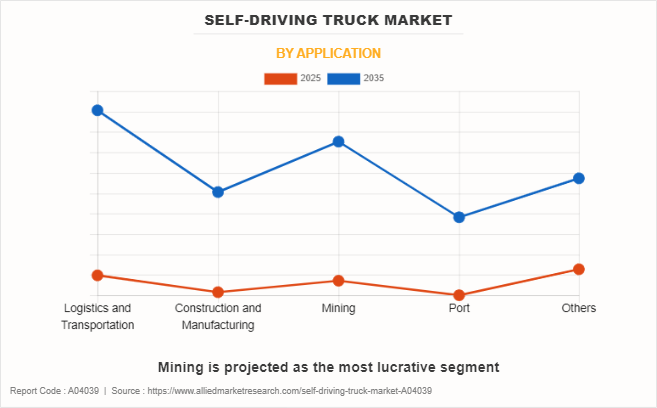
Moreover, the companies operating across the globe have been testing their self-driving technology along with OEMs to measure the performance of the vehicle. For instance, in June 2023, TuSimple, the provider of autonomous trucking software, successfully travelled approximately 62.76 kilometers on an open public road in China, safely negotiating typical traffic.
There was no human occupant or outside assistance in the truck. Similarly, in July 2023, the IVECO S-Way truck equipped with PlusDrive, Plus's advanced driver-assist solution based on its open autonomy platform, began running on public roads in Germany, according to IVECO, the commercial vehicle brand of Iveco Group.
In addition, government support towards advancement of the self-driving vehicle infrastructure has also created a wider scope for the growth of the market across the globe. For instance, in June 2022, Einride received an approval from the National Highway Traffic Safety Administration (NHTSA) of the U.S. to test & operate its autonomous trucks in the U.S. roads. Similarly, Australia has been testing a wider fleet of autonomous mining trucks in its iron & other mineral ores wherein trucks are operating autonomously transporting the minerals from mines to the collection centers. Such testing & development toward commercializing self-driving trucks creates a wider scope for the growth of the market during the forecast period.
The factors such as development of intelligent transport system, growth of connected infrastructure, and improved safety coupled with reduction in traffic congestion supplement the growth of the self-driving truck market. However, rise in security and privacy concerns, and software failures associated with automotive sensors are the factors expected to hamper the growth of the self-driving truck industry. In addition, decongestion of traffic and supportive government regulation creates market opportunities for the key players operating in the self-driving truck technology market.
Aurora Innovation Inc., TuSimple, and Embark Trucks are among the many self-driving truck technology companies around the world. The global self-driving truck market is segmented by component, application, autonomous level, propulsion type, and region. By component type, the market is divided into hardware, software, and service.
Depending on application, the market is segmented into construction & manufacturing, logistics & transportation, mining, port, and others. Based on autonomous level, the market is segmented into Level 1, Level 2, Level 3, Level 4, and Level 5. By propulsion type, the market is divided into internal combustion engine, hybrid transmission, and electric transmission. Region wise, the market is analyzed across North America, Asia-Pacific, Europe, and LAMEA.
Key Market Players
The key players in self-driving truck market include Einride, Waabi, RRAI, Jiluo Technology (Shanghai) Co., Ltd., Aurora Innovation Inc., TuSimple, Embark Trucks, Inc., PlusAI, Inc., Torc Robotics, Kodiak Robotics, Inc.
Development of intelligent transport system
Intelligent transportation systems (ITS) were devised in response to the rise in need for services related to various modes of transportation and traffic management. The ITS allows users to be better informed and to use the transportation network in a safer, more coordinated, and smarter manner. The technologies used in intelligent transportation systems range from basic management systems such as vehicle navigation, traffic signal control systems, container management systems, variable message signs, automatic number plate recognition, or speed cameras, to monitoring applications automatic incident detection or stopped vehicle detection systems, to more advanced application such as automatic incident detection or stopped vehicle detection systems.
The development of intelligent transport systems across the world has boosted the growth of transportation and logistics services. The developments in the transportation industry further increase the sales of heavy commercial vehicles such as trucks and buses worldwide. The evolution of automotive technologies has facilitated the development of intelligent transport systems. The semi-autonomous and autonomous vehicle industry is projected to experience growth during the forecast period due to sheer advancement of intelligent transportation systems.
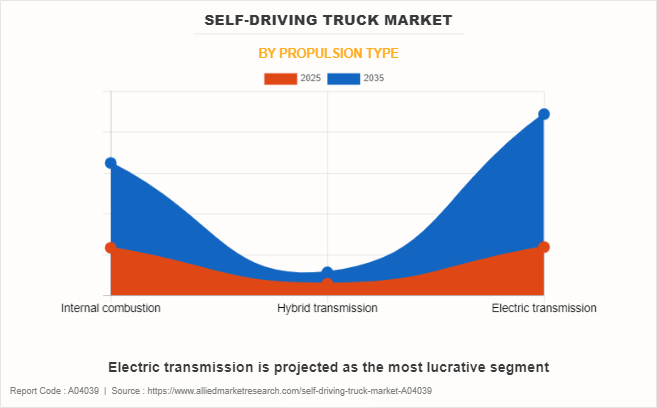
Growth of connected infrastructure
With the rapid adoption of Internet of Things (IoT), transportation infrastructure across the globe is evolving quickly. Companies such as Cisco and IBM have created digital platforms, which can automate street and traffic lights, optimize trash pickup, and augment surveillance.
For instance, installation of IoT sensors in the streets of Las Vegas has managed to control traffic congestion and solve environmental issues. Connected infrastructure includes vehicle parking, toll booths, and smart-street and traffic lights. Thus, growth of connected infrastructure creates favorable conditions for adoption of autonomous trucks, which, in turn, drives the growth of the market.
Connected vehicles are equipped with advanced automotive systems such as navigation systems, GPS tracking, and automotive telematics devices through which they can exchange information wirelessly not only with other vehicles and supporting infrastructure but also with vehicle manufacturers or third-party service providers, although customers are more likely to entrust their data to OEMs than to newer players. Moreover, demand for connected infrastructure in vehicles is increasing worldwide and buyers are willing to pay more for connected features. Vehicle dealers benefit from connected vehicle technology as they receive alerts on their systems when their connected vehicle customers are due for service.
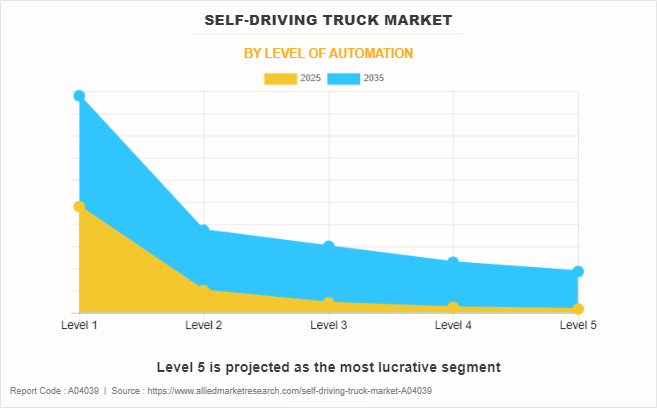
This allows them to follow up with their customers to take care of regular maintenance and repairs. Moreover, telematics aids manufacturers to create high-value services for consumers and play a vital role in vehicle connected technology. Popularity of telematics is getting bigger and is gaining momentum across developed and developing nations globally. Big market players from the telecommunications and automotive industry are quite active in the market. They are largely working in the telematics segment and creating superior solutions in infotainment and navigation fields.
Rise in security and privacy concerns
Self-driving trucks have enhanced the travelling experience, owing to its benefits such as high speed, environment-friendly nature, and energy-efficient approaches. The self-driving truck uses camera for lane detection, a LIDAR sensor to create a 3D environment, infrared radar sensor to detect obstacles and other vehicle on the road, and GPS sensor to help pinpoint the truck location and complex algorithms that allow the truck to drive itself. However, privacy and security concerns related to information access from the operating software are expected to hinder the market growth, as these software are vulnerable to hackers.
Although a person supervises the self-driving system, there is a high possibility that hackers can infiltrate the software and overrule the controls. Thus, increase in threats from hackers and rise in cybercrime are expected to limit the market growth in the coming years.
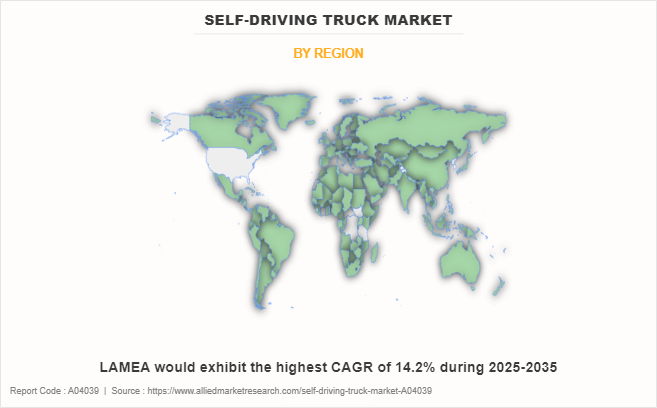
Supportive government regulation
Governments across countries implement regulations in support of autonomous vehicles. For instance, in September 2017, the U.S. House of Representatives passed a bill for Safely Ensuring Lives Future Deployment and Research in Vehicle Evolution Act, or Self-Drive Act, which is waiting to get cleared from the Senate. The role of this act is to establish a federal framework for the regulation of self-driving trucks.
At present, the autonomous vehicle market players interested in testing driverless technology need to apply for exemptions to the National Highway and Traffic Safety Administration’s (NHTSA) federal motor vehicle safety standards, and the agency only grants 2,500 per year. The Self-Drive Act is projected to increase that cap to 25,000 per year initially, and expand it to 100,000 annually in three years’ time. Such developments are expected to create ample opportunities for the growth of the market across the globe.
Key Developments
- In June, 2023, Einride partnered with PostNord to offer a digital, electric and autonomous technology, in Norway and helps the region to reduce emission and attain carbon neutrality. The partnership is expected to help the company to showcase its product and its capability in the region.
- In March, 2023, Cavnue (CAVs) and Robotic Research (RRAI) collaborated on advancing the future of highly automated transit across the U.S. The collaboration will help the company to support its commercial ADAS and autonomy systems.
- In March, 2023, Nestle and Inceptio Technology's collaborated to promote and implement autonomous driving technology in line-haul logistics. This initiative has introduced novel approaches and strategies for companies to enhance cost efficiency and provide safe freight services.
- In April, 2023, Continental and Aurora Innovation, Inc. have formed a partnership to create the first commercially scalable generation of Aurora's flagship integrated hardware and software system, the Aurora Driver. The companies will collaborate to design, build, validate, deliver, and support a scalable autonomous system for the trucking industry. The partnership is expected to provide expertise of the continental's software and hardware technology.
- In June, 2023, TuSimple, the provider of autonomous trucking software, successfully travelled approximately 62.76 kilometres on an open public road in China, safely negotiating typical traffic. There was no human occupant or outside assistance in the truck.
Key Benefits For Stakeholders
- This report provides a quantitative analysis of the market segments, current trends, estimations, and dynamics of the self-driving truck market analysis from 2025 to 2035 to identify the prevailing self-driving truck market opportunities.
- The market research is offered along with information related to key drivers, restraints, and opportunities.
- Porter's five forces analysis highlights the potency of buyers and suppliers to enable stakeholders make profit-oriented business decisions and strengthen their supplier-buyer network.
- In-depth analysis of the self-driving truck market segmentation assists to determine the prevailing market opportunities.
- Major countries in each region are mapped according to their revenue contribution to the global market.
- Market player positioning facilitates benchmarking and provides a clear understanding of the present position of the market players.
- The report includes the analysis of the regional as well as global self-driving truck market trends, key players, market segments, application areas, and market growth strategies.
Self-Driving Truck Market Report Highlights
| Aspects | Details |
| Market Size By 2035 | USD 41.2 billion |
| Growth Rate | CAGR of 12.1% |
| Forecast period | 2025 - 2035 |
| Report Pages | 332 |
| By Component |
|
| By Application |
|
| By Level of Automation |
|
| By Propulsion Type |
|
| By Region |
|
| Key Market Players | Embark Trucks, Inc., Aurora Innovation Inc., Torc Robotics, Waabi, PlusAI, Inc., Kodiak Robotics, Inc., RRAI, TuSimple, Einride, Jiluo Technology (Shanghai) Co., Ltd. |
Analyst Review
Self-driving trucks is also known as autonomous truck. It uses infrared radars, sophisticated motion sensors, incredibly accurate sensors LIDAR (laser radar), cameras, and complex algorithms that allow the truck to drive itself.
The conventional vehicles are usually a combination of expensive, slow, and environmentally harmful factors. Road travel is particularly problematic, owing to emission of hazardous air pollutants. As the environmental impact of energy consumption continues to worsen, mass transit is anticipated to be crucial in the years to come, which creates the demand for technology such as self-driving truck. Rise in environmental concern majorly drives the growth of the self-driving truck market. Moreover, factors such as reduced wind drag, less road accident, decongestion of traffic and others also fuel the market growth.
The global self-driving truck market is projected to witness considerable growth, especially in Asia-Pacific due to increase in number of road accidents and rise in environment concerns. North America is expected to account for majority market share of the self-driving truck market in 2020.
Introduction of advanced self driving software are the upcoming trends of Self-Driving Truck Market in the world
Mining is the leading application of Self-Driving Truck Market
North America is the largest regional market for Self-Driving Truck
The global self-driving truck technology market is expected to be valued at $13,111.7 million in 2025, and is projected to reach $41,216.7 million by 2035, registering a CAGR of 12.1% from 2025 to 2035.
The key players in self-driving truck technology include Einride, Waabi, RRAI, Jiluo Technology (Shanghai) Co., Ltd., Aurora Innovation Inc., TuSimple, Embark Trucks, Inc., PlusAI, Inc., Torc Robotics, Kodiak Robotics, Inc.
Loading Table Of Content...
Loading Research Methodology...


